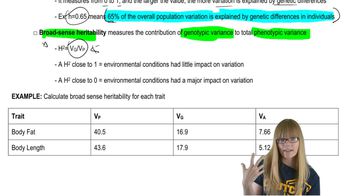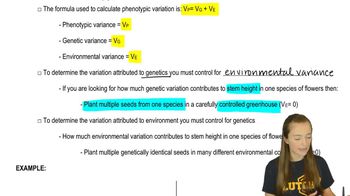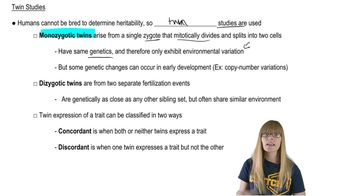Table of contents
- 1. Introduction to Genetics51m
- 2. Mendel's Laws of Inheritance3h 37m
- 3. Extensions to Mendelian Inheritance2h 41m
- 4. Genetic Mapping and Linkage2h 28m
- 5. Genetics of Bacteria and Viruses1h 21m
- 6. Chromosomal Variation1h 48m
- 7. DNA and Chromosome Structure56m
- 8. DNA Replication1h 10m
- 9. Mitosis and Meiosis1h 34m
- 10. Transcription1h 0m
- 11. Translation58m
- 12. Gene Regulation in Prokaryotes1h 19m
- 13. Gene Regulation in Eukaryotes44m
- 14. Genetic Control of Development44m
- 15. Genomes and Genomics1h 50m
- 16. Transposable Elements47m
- 17. Mutation, Repair, and Recombination1h 6m
- 18. Molecular Genetic Tools19m
- 19. Cancer Genetics29m
- 20. Quantitative Genetics1h 26m
- 21. Population Genetics50m
- 22. Evolutionary Genetics29m
20. Quantitative Genetics
Heritability
Problem 19a
Textbook Question
In a population of 100 inbred, genotypically identical rice plants, variance for grain yield is 4.67. What is the heritability for yield? Would you advise a rice breeder to improve yield in this strain of rice plants by selection?
 Verified step by step guidance
Verified step by step guidance1
<span>Step 1: Understand the concept of heritability. Heritability in the broad sense (H^2) is the proportion of the total phenotypic variance (V_P) that is due to genetic variance (V_G). It is calculated as H^2 = V_G / V_P.</span>
<span>Step 2: Recognize that in inbred, genotypically identical populations, the genetic variance (V_G) is essentially zero because all individuals have the same genotype. Therefore, any observed variance in the trait is due to environmental factors.</span>
<span>Step 3: Since V_G is zero, the heritability (H^2) for grain yield in this population is also zero. This means that none of the observed variance in grain yield is due to genetic differences among the plants.</span>
<span>Step 4: Consider the implications for breeding. Since heritability is zero, selection based on phenotypic differences will not lead to genetic improvement in yield because the differences are not genetically based.</span>
<span>Step 5: Advise the rice breeder. Given the zero heritability, it would not be effective to improve yield in this strain by selection. The breeder might consider introducing genetic variation through crossbreeding with other strains to create a population with genetic diversity.</span>
Recommended similar problem, with video answer:
 Verified Solution
Verified SolutionThis video solution was recommended by our tutors as helpful for the problem above
Video duration:
1mPlay a video:
Was this helpful?
Key Concepts
Here are the essential concepts you must grasp in order to answer the question correctly.
Heritability
Heritability is a measure of how much of the variation in a trait, such as grain yield, can be attributed to genetic differences among individuals in a population. It is expressed as a ratio, ranging from 0 to 1, where a higher value indicates a greater genetic contribution to the observed variation. Understanding heritability helps breeders determine the potential effectiveness of selection for improving traits.
Recommended video:
Guided course

Calculating Heritability
Variance
Variance is a statistical measure that represents the degree of variation or dispersion of a set of values. In the context of genetics, it quantifies how much individual traits, like grain yield, differ from the average trait value in a population. A higher variance indicates a wider range of trait expression, which can influence the potential for selection and breeding strategies.
Recommended video:
Guided course

Analyzing Trait Variance
Selection in Breeding
Selection in breeding refers to the process of choosing individuals with desirable traits to reproduce, thereby increasing the frequency of those traits in future generations. In the case of rice plants, if heritability is high, it suggests that selection could effectively improve grain yield. Conversely, if heritability is low, the impact of selection may be limited, making it less advisable to pursue this strategy.
Recommended video:
Guided course

Artificial Selection

 7:04m
7:04mWatch next
Master Calculating Heritability with a bite sized video explanation from Kylia Goodner
Start learning

